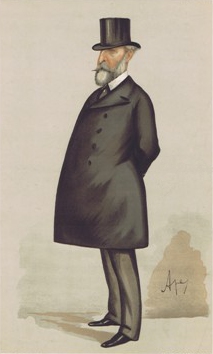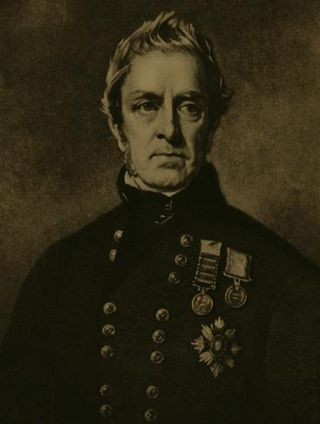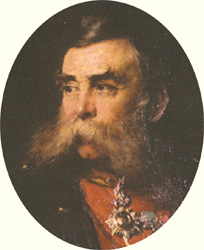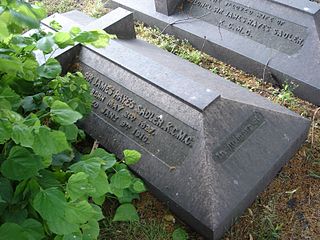
Colonel Aylmer Spicer Cameron was a British Army officer and recipient of the Victoria Cross, the highest and most prestigious award for gallantry in the face of the enemy that can be awarded to British and Commonwealth forces.

Major General George Alexander Renny VC was a recipient of the Victoria Cross, the highest and most prestigious award for gallantry in the face of the enemy that can be awarded to British and Commonwealth forces.

Lieutenant General Sir Edward Bruce Hamley was a British general and military writer and a Conservative politician who sat in the House of Commons from 1885 to 1892.

Field Marshal Sir John Fox Burgoyne, 1st Baronet, was a British Army officer. After taking part in the Siege of Malta during the French Revolutionary Wars, he saw action under Sir John Moore and then under the Duke of Wellington in numerous battles of the Peninsular War, including the Siege of Badajoz and the Battle of Vitoria. He served under Sir Edward Pakenham as chief engineer during the War of 1812. He went on to act as official advisor to Lord Raglan during the Crimean War advocating the Bay of Kalamita as the point of disembarkation for allied forces and recommending a Siege of Sevastopol from the south side rather than a coup de main, so consigning the allied forces to a winter in the field in 1854.

Field Marshal Sir George Pollock, 1st Baronet was a British Indian Army officer. He first saw action at the Battle of Deeg and at the Siege of Bhurtpore during the Second Anglo-Maratha War before taking part in the Anglo-Nepalese War. He also commanded the British artillery at the Battle of Prome and at Bagan during the First Anglo-Burmese War. Following a disastrous retreat from Kabul in January 1842 during the First Anglo-Afghan War, the retreating forces became stranded at the small British garrison at Jalalabad and Pollock was appointed Commander of the Force sent to relieve the garrison: he advanced through the Khyber Pass and relieved the garrison in April 1842. He then set about an unauthorised but ultimately successful mission to rescue the British hostages who had been left behind in Kabul prior to the retreat. In 1844 the Pollock Medal was created to commemorate Pollock's achievements: this medal was to be awarded to the "best cadet of the season" at the Addiscombe Military Seminary.

Field Marshal Sir Hew Dalrymple Ross, was a British Army officer. After seeing active service during the Irish Rebellion of 1798, he fought as a troop commander in many of the battles of the Peninsular War and the Hundred Days. He went on to become the Artillery Commander, Northern District with delegated command over all the forces of the four northern counties before being promoted to Deputy Adjutant-General, Royal Artillery. Ross was the last person to hold the title of Lieutenant-General of the Ordnance, assuming responsibility for the artillery component sent to take part in the Crimean War under Lord Raglan. After the war he served as Master Gunner, St James's Park, a senior ceremonial post in the Royal Artillery.

General William Rose Mansfield, 1st Baron Sandhurst was a British military commander who served as Commander-in-Chief of India from 1865 to 1870.

Field Marshal Sir John Lintorn Arabin Simmons was a British Army officer. Early in his career he served as Inspector of Railways, Secretary of the Railways Commission and then Secretary of the Railway Department under the Board of Trade. He went on to be British Commissioner with the Turkish Army providing advice to General Omar Pasha during the Crimean War. He assisted the Turks at the defence of Silistra and then led them at the Battle of Giurgevo before landing with them at the Battle of Eupatoria and remaining with them for the Siege of Sevastopol. After that he became British Consul in Warsaw, Commander, Royal Engineers at Aldershot and then Director of the Royal Engineer Establishment in Chatham. He went on to be Lieutenant-Governor of the Royal Military Academy and subsequently Governor of the Academy. His last appointments were as Colonel Commandant of the Royal Engineers, as Inspector General of Fortifications and then as Governor of Malta.
Sir William Palliser CB MP was an Irish-born politician and inventor, Member of Parliament for Taunton from 1880 until his death.

Colonel Sir James Hayes Sadler was a British diplomat and civil servant.

Field Marshal Sir Richard James Dacres, was a British Army officer during the nineteenth century. Born into a substantial naval dynasty, he would achieve similar status in the military, commanding three troops of Royal Horse Artillery at the Battles of Alma in September 1854, Balaclava in October 1854 and Inkerman in November 1854, and throughout the Siege of Sevastopol during the Crimean War and eventually rising to the rank of field marshal.
Lieutenant-General Edward Seager (1812–1883) was a British Army officer who served in the Crimean War and in the Indian Mutiny.

Lieutenant-General Sir Percy Egerton Herbert was a British Army officer and Conservative politician.

General Sir Henry John William Bentinck KCB was a British soldier and courtier.

Field Marshal Lord William Paulet, was a senior British Army officer. During the Crimean War he served as Assistant Adjutant-General of the Cavalry Division, under Lord Lucan, at the Battle of Alma in September 1854, at the Battle of Balaklava in October 1854 and at the Battle of Inkerman in November 1854 as well as at the Siege of Sevastopol during the Crimean War. He was then given command of the rear area, including the Bosphorus, Gallipoli and the Dardanelles before returning to England. He later became Commander of the 1st Brigade at Aldershot in 1856, General Officer Commanding South-West District in 1860 and finally Adjutant-General to the Forces in 1865.

General Sir Richard Chambré Hayes Taylor was a senior British Army officer who served in the Second Anglo-Burmese War, the Crimean War and the Indian Mutiny. Joining the General Staff in 1860, he was the British Army's Inspector General of Recruiting, then Deputy Adjutant-General to the Forces, briefly Adjutant-General, and finally for three years Governor of the Royal Military College, Sandhurst. He was also Colonel of the Queen's Own Cameron Highlanders and the East Surrey Regiment.

Major-General Reynell George Taylor was a British military officer who served in the Bengal Army.

General Sir John Cheape was a Scottish military officer of the Bengal Army in British India.
Gloucester Gambier was an English first-class cricketer and British Army officer.
General Sir Alexander Lindsay KCB was an officer in both the British and East India Company armies. Commissioned into the British Army at the age of nine, he was placed on half-pay after the 104th Regiment of Foot was disbanded in 1795.
















